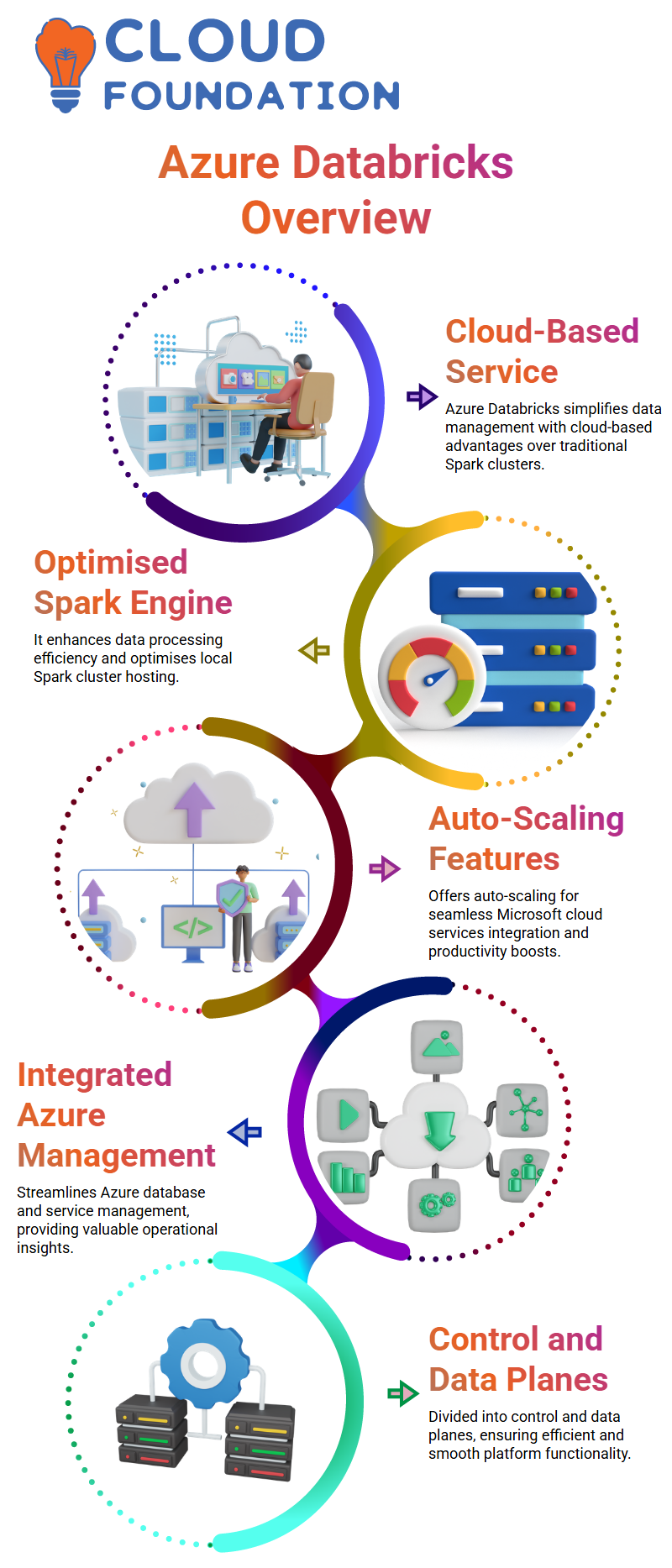Azure Data Bricks Tutorial
What is Databricks?
Databricks is an internet-based platform offering automated cluster management and Python notebooks designed specifically for data science professionals and data analysts.
Databricks was developed by the original creators of Apache Spark as an online platform to implement it with locally hosted clusters. Databricks provides various options for interfacing with Spark via an intuitive web-based interface.
As well as offering automated cluster management that is entirely software-based and free from manual oversight, Data Lab also features Python notebooks for those interested in data science or analytics.
Data bricks are an aggregation tool for merging data from multiple sources – big data, scientific data engineering and machine learning among them – into one cohesive package for further processing or machine learning purposes. When combined with Azure Data Bricks as a cloud service offering users can set up and use clusters of instances or Virtual Machines running Azure.
Data brick utilities offer another method for quickly and effortlessly installing libraries into an environment, eliminating manual downloads and installations while providing effortless collaboration among data analytics or science teams.
Databricks allows for effortless visualisation of data, making it a useful tool for various data analysis and visualisation needs. Users can take advantage of Databricks to streamline data management while increasing overall productivity.
What is Azure Databricks?
Azure Databricks is a cloud-based service from Microsoft which has several advantages over conventional Spark clusters. Due to being managed directly, this provides several distinct benefits over their use in cluster environments.
Azure Databricks provides an effective means for analysing large and diverse amounts of information, offering several distinct advantages over conventional Spark clusters.
An improved Spark engine facilitates more effective data processing and optimization, making this an excellent solution for hosting local Spark clusters in office spaces or server rooms.
Azure Databricks’ autoscaling features make it the perfect way to manage data efficiently and increase productivity, offering automatic scaling features across Microsoft paid services as well as cloud services – making Azure Databricks the go-to choice for managing information efficiently and enhancing productivity.

Azure Databricks simplifies this task for its users by taking care of managing clusters and overseeing instances’ maintenance on their behalf.
Azure Databricks is an invaluable tool for efficiently and seamlessly managing and integrating Microsoft Azure databases and services, offering valuable insight into its capabilities and advantages for users. By understanding its architecture and putting into effect effectively, users gain crucial understanding about this platform’s benefits and capabilities.
Architecture of Azure Databricks
Azure Databricks is an impressive solution for managing notebooks and data processing efficiently and streamlined operations. By prioritising control plane and data plane activities, Databricks ensures all necessary services are efficiently executed for smooth platform functioning.
Azure Databricks is divided into two areas:
The control plane
The data plane.
The control plane: Databricks uses its control plane as the storage location for backend services. Data from web applications, customer notebooks and any related info residing with Data Bricks will also be stored here in an organized fashion. Essentially this box represents all data which needs to be processed.
An interface which enables customers to sign on securely with other Databricks and connect through Azure Databricks cloud accounts that offer them as managed solutions. Within each Databrick there exists an entire box called a control plane containing data which needs processing; its location within these cloud accounts lies within their management solution for data analysis.
This account itself encompasses one cloud account that houses all necessary control planes needed for data-driven workflow to function effectively.
A control plane is an integral element of customer workflows; here all publication-related data are securely stored for later reference within their workspace one planes. Likewise, information available only within these control planes.
Control planes enable users to manage their data effectively and efficiently by selecting specific data points before selecting their type. In doing so, users will have an effective and efficient means of managing their information effectively and efficiently.
The data plane: Data plane is where customers’ data is managed entirely without being passed to any control plane for processing or storage. When data breaks are opened in Azure accounts of customers, these appear in browser with user interface (UI).
Data-driven workflow is like any web app in that users are able to gain access to publication-related information through it.
Each plane exists as part of customer cloud accounts with clusters taking care of processing the data within these plans.
Data processing occurs primarily within the data plane. It acts as the primary storage layer for all information while backend services reside on the control plane.
This plane provides storage capacity for various data types including books, job-related details and logging related details.
Advantages of Azure Databricks
Azure Databricks can offer users a key benefit by acting as an abstraction layer between themselves and cluster complexities, which means users don’t need to direct attention towards this aspect directly.

This abstraction allows users to focus on solving specific use cases efficiently while sidestepping cluster complexities. These services are far more cost-efficient.
Azure Databricks takes away from users the burden of dealing with cluster complexities; hence the invisible icon seen here; users do not interact directly with it. utilizatorilor Azure Databricks allows for users to gain access and manage their data without direct interaction from its cluster.
As users can more easily access and manage large datasets like those of Spa Cluster, users are less overwhelmed by its complexity. With Azure Databricks being an optimised Spark engine that facilitates data processing with auto-scaling capability.
Databricks File System(DBFS)in AzureDatabricks
Databricks File System (DBFS) provides users with a storage layer designed specifically to meet their storage requirements and personal information within an Azure account. Users are able to easily create, organize, manage, upload, process data that meets individual user needs using this centralized approach to storage management.
Databricks file system features an intelligent data processing logic system which performs data resets. Furthermore, its design facilitates ease of use and maintenance by featuring an easy single sign-on interface which enables users to connect easily to other Databricks instances.
This high-level architecture ensures efficient data administration and access across multiple databases.
Microsoft Azure in AzureDatabricks
Microsoft Azure Data Bricks provides an effective and secure means of data protection, featuring enterprise-grade security and native protection by Microsoft Ashore as well as private workspaces. Azure itself serves as an efficient cloud computing platform which enables users to efficiently manage both their resources and data.
Pay-as-you-go services such as this provide users with a flexible pay model where only those paying per user pay, regardless of if or when hardware was acquired for local usage.
Businesses that require extensive data management find this model particularly advantageous as it helps them efficiently oversee resources and infrastructure needs.
Microsoft Azure provides users with an innovative tool for designing and managing data models. Users can store models within its central repository so that colleagues may easily access them.
Data bricks rely heavily on language selection – whether Microsoft SQL or.NET. Once their cluster has been set up, users can select their favorite dialect to start writing their notebook.
Microsoft Azure provides an adjustable payment model, making resource management more flexible for its users. Businesses can leverage it by centralizing data storage on one server – taking full advantage of cloud computing’s many benefits!
Azure Cloud Services in AzureDatabricks
Microsoft Azure Cloud Services will feature collaborative notebooks that allow team members to quickly access and analyze data quickly.

These notebooks can be shared among teammates to enable them to view and execute code, make modifications and optimise it as necessary, as well as collaborate more easily together with one another.
Azure Cloud Services aren’t the only cloud services on offer; other options, including Amazon Web Services (AWS), Google Cloud Platform and Microsoft Azure can all provide features and benefits that make creating and managing Azure accounts simpler for users.
Microsoft Azure Cloud Services offer users a host of features to collaborate, access and explore data more efficiently and collaboratively.
Utilizing these features, users can enrich their Azure experience while increasing productivity and efficiency.
Coding notebook in AzureDatabricks
Coding notebooks are effective ways of organizing data in an orderly and effective fashion, helping ensure it remains stored safely and efficiently.
Coding notebook is a tool designed to enable users to efficiently write, store, process and archive code that they create or manage in various forms (codebook, notebook, database service or blob storage service).
Notebooks can be invaluable tools for managing data. Users can quickly add and remove items without the need to retype, making this form particularly effective when managing large datasets like taxi job data, online taxi services or trip distance.
Data analyst inAzureDatabricks
Data analysts often create notebooks using resources belonging to one cluster for ease of data integration. To do this, tokens need to be generated in order to access specific periods within their resource group.
Scala, which is an industry standard programming language.
A data analyst should create a notebook using identical cluster, container, and storage names from their existing laptop to the newly generated one.
Data analysts must switch out all existing notebooks with new ones of similar format in order to easily use future analysis on them. Doing this ensures that new laptop is readily accessible.
Conclusion
Azure Databricks is an enterprise-class cloud platform designed to streamline the management and processing of large datasets. Utilizing Apache Spark as its optimized engine enables seamless collaboration among data engineers, scientists, and analysts within one unified workspace.

Integration with Microsoft Azure ensures robust security, efficient resource utilization and scalability – an ideal combination for companies dealing with large datasets.
Azure Databricks enables users to focus more on data-driven workflows and insights rather than infrastructure complexity, thanks to its abstraction of cluster complexities, auto-scaling features and seamless integration with other Azure services. Its abstraction layer, autoscaling functions and seamless integration allow it to meet users’ data processing requirements seamlessly while seamlessly integrating other Azure services for optimal use cases.
Azure Databricks provides an all-in-one, flexible, and secure platform that accelerates productivity by processing, analysing, visualising and making decisions based on data-driven decisions more rapidly.

Vinitha Indhukuri
Author
Success isn’t about being the best; it’s about being better than you were yesterday.



